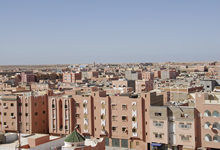 The housing and urban planning sector in the Sahara has gone through tremendous change since it regained independence, particularly after the notable success of the various housing programmes and projects, which resulted in several residential complexes that have effectively integrated the urban areas in compliance with the urban planning development prepared for this purpose. The efforts in urban development aimed at reaching three major objectives:
The housing and urban planning sector in the Sahara has gone through tremendous change since it regained independence, particularly after the notable success of the various housing programmes and projects, which resulted in several residential complexes that have effectively integrated the urban areas in compliance with the urban planning development prepared for this purpose. The efforts in urban development aimed at reaching three major objectives:
-
Re-accommodating the families in most need as they were living outside the urban area or in indecent conditions;
-
Meeting the growing need for housing by putting an end to the crisis that many families were suffering from;
-
Upgrading the urban area through the balanced distribution of the population and the houses with their various materials and equipment.
The dimensions taken by the plans of the housing and urban planning sector on behalf of the Southern provinces required the revision of the adopted methods and ways of working to increase the number of houses that are in conformity with the social and urban requirements, the fighting of unsanitary housing. Based on the official 2004 census of the population and the houses, the population of Laayoune Province reached 210,023, that is an annual increase of 3.2 %. This population is centered predominantly in the urban areas, which accommodate 164,807 people, i.e. 93.81% of the population of the whole region, against only 10,862 people for the rural areas. This number exceeds by far the national average which reached 51.4% in 1994.
An urgent programme has been implemented to build 2,847 decent urban houses, and 2,305 housing lots. The ‘return residential development’ housing programme is considered the most important of one as it has provided the first section of the programme about 1450 houses in the city of Laayoune, while the second section is expected to offer around 1,550 houses in the territory of the commune of Laayoune.
On the other hand, there are other programmes underway, relating to the first section of the programme of the city of union, which provides 2144 residential developments, in addition to the ‘National Reconciliation’ development Project, which is expected to offer 1500 modern urban houses.
With regards to the Province of Smara, it is characterized by its large demography, particularly following the stability prevailing in the province. Thus, the population of the Province of Smara has reached, according to the official general census of the population and houses, 60,426 people for the year 2004.
It is to be noted that the majority of the population in the Province of Smara is centered in the urban areas, due to the main housing facilities provided there. Some development projects have also been launched in the rural areas through the reinforcement of the infrastructure and the provision of basic facilities such as schools, roads, and clinics.
Whereas the population of Oued Eddahab-Lagouira Region reached 36,751 people in 1994, with the urban areas accounting for 85%, the Demographic Research and Studies Centre indicates that the population of the region was around 54,000 in 2003.
The gross demographic growth registered in the region between the census of 1982 and that of 1994 has gone up to about 15,255 people, which shows a gross annual increase amounting to an average of 1271 people. These population increases have particularly occurred in the urban areas at a rate of 87% overall. This rise is due to the significant inflows of people from various areas of the Kingdom to the city of Eddakhla and the fishing centres more particularly because of employment opportunities generated by the fishing sector.